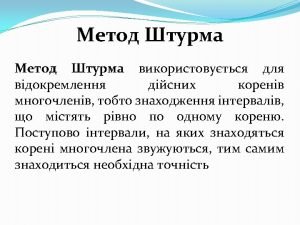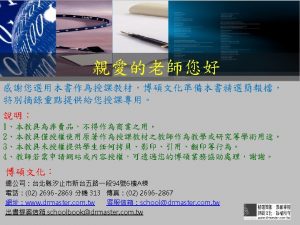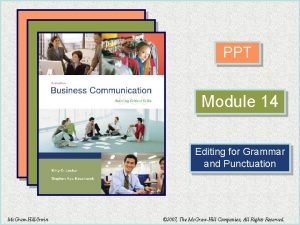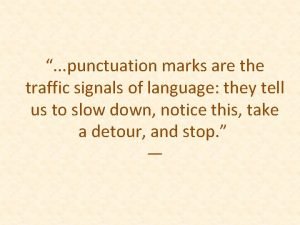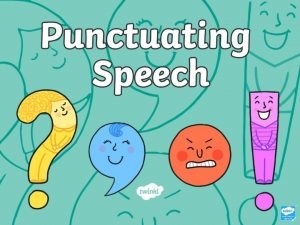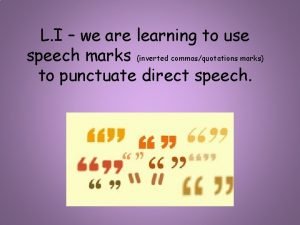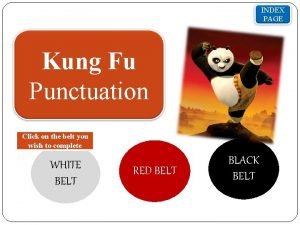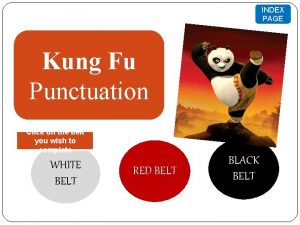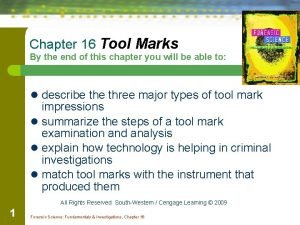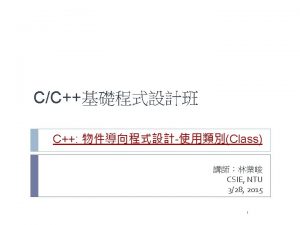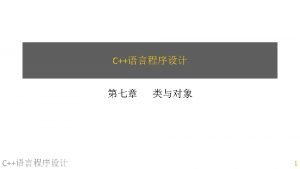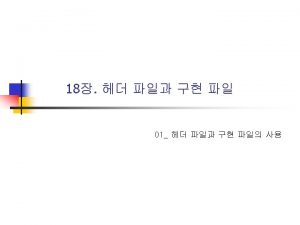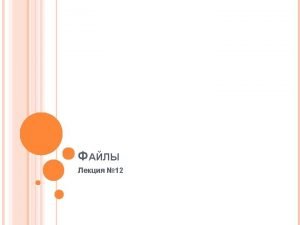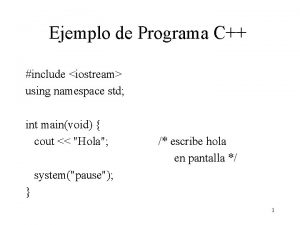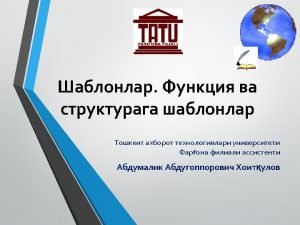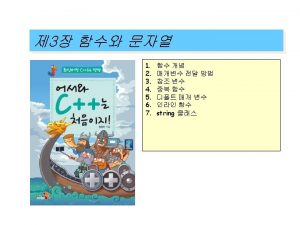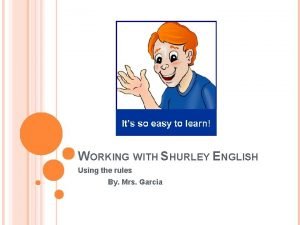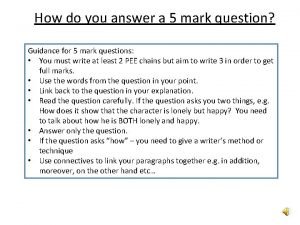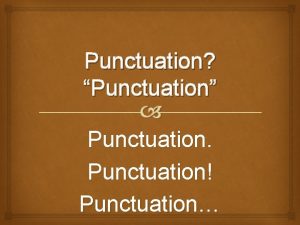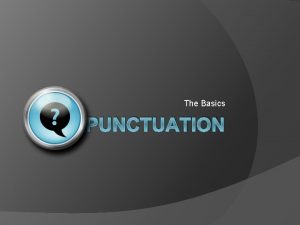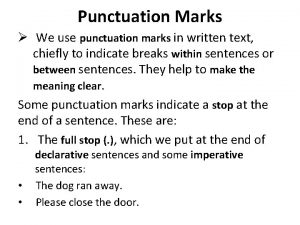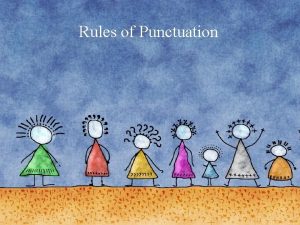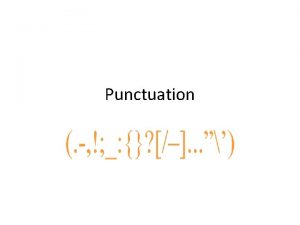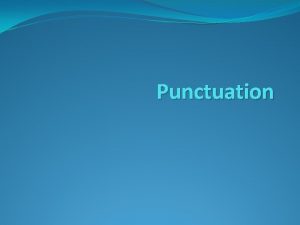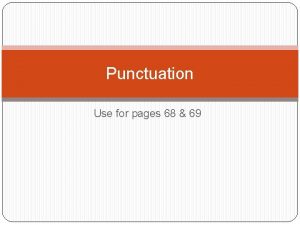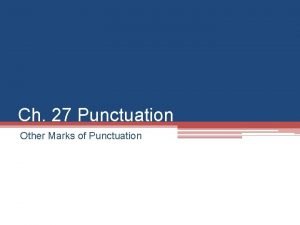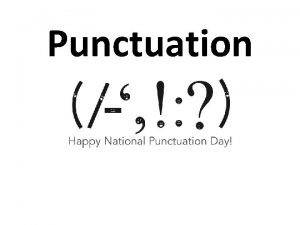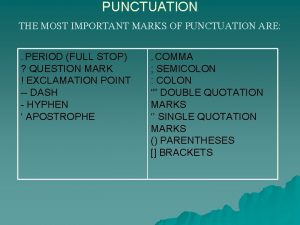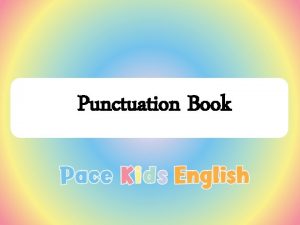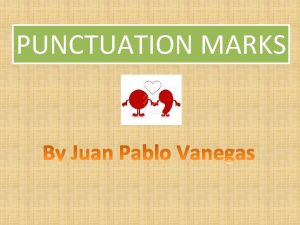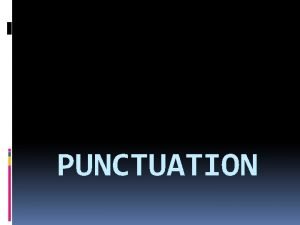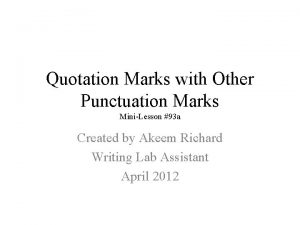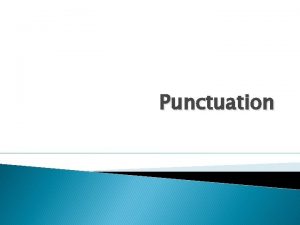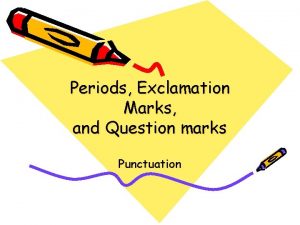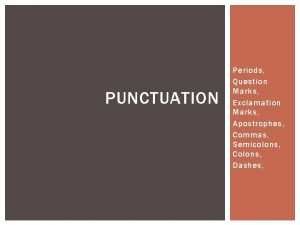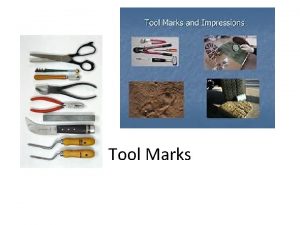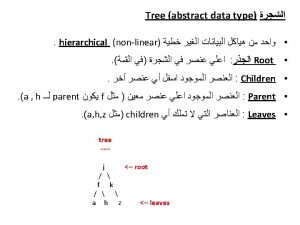PUNCTUATION MARKS The punctuation marks in English include










































- Slides: 42

PUNCTUATION MARKS

• The punctuation marks in English include the period or full stop(. ), the comma(, ), the semicolon(; ), the colon(: ), the question mark (? ), the exclamation mark (!), the quotation marks – double or single (‘’ ‘’ or ‘ ‘), the apostrophe (‘), the dash (-), the parentheses or brackets [ ] or () and ellipsis (…). Most of these marks have highly specialised functions, and once these are understood, it is easy to use them conventionally.

The Period or Full Stop (. ) • The full stop is used to mark the end of a declarative sentence. Unless a sentence is intended as a question, a command or an exclamation, it is declarative and is closed with a period.

Examples 1. I am a student. 2. I need a pen. 3. Today is Sunday.

• It is used to mark accepted abbreviations. These include

• Titles : Col. Dr. Hon. Rev. • Degrees : B. A. B. Sc. M. D. Ph. D. • Names: John K. Abugri, Daniel O. Mensah • Miscellaneous: Ave. St. Vol. U. S. A. B. C. A. D. • Hours and minutes represented in figures : 2. 30 p. m.

The Comma (, ) • The comma is used to separate elements which might otherwise seem to run together. a. To prevent a confused or ambiguous sentence or construction 1. Mr Amoako our lecturer has travelled. 2. Mr Amoako , our lecturer has travelled. 3. Mr Amoako, our lecturer, has travelled

• To separate two main clauses joined by a coordinating conjunction The coordinating conjunctions are and, or, nor and but. This use of the comma is a style in American English. 1. The minister advised them, and afterward gave them presents. 2. He works very hard, but he was selected for promotion.

• To separate elements in a series 1. Esi bought tomatoes, pepper and onions. 2. Reading, swimming and dancing are my favourite recreations.

• To separate contrasted elements in a this, not that construction 1. He is a student, not a lecturer. 2. We are disgusted, not angry. 3. It is a computer, not a television.

• To separated a direct quotation from such constructions as he said, she answered, we replied, etc. 1. ‘’I am hungry’’, she said. 2. ‘’This’’, he said, ‘’is your last chance. ’’ 3. Jesus advised, ‘’Pray without ceasing. ’’

• To separated elements in dates, addresses and names of places v. Dates – May 23, 1950 v. Addresses – 123 Bomso Street, Kumasi, Ghana

• Commas are used to set off interrupting constructions. Interrupting constructions disrupt the flow of sentences. a. Appositives 1. Mr Amoako, a senior lecturer, has been awarded 2. Nelson Mandela, the former president of South Africa, died sometime ago.

b. Nouns of address or vocatives 1. Sir, I’d like to ask a question. 2. Madam, I don’t understand it. 3. I am very hungry, Mum.

c. Conjunctive adverbs and other transitional markers. 1. We thought, moreover, that we could get away with it. 2. You must try, first of all, to forgive him.

d. Non- restrictive modifiers or clauses (unessential modifications) 1. The sun, which gives us light during the day, is very bright. 2. Christians, who are followers of Christ, must live exemplary lives.

• Long introductory phrases or an adverbial clauses. 1. Having been presented with the cheque, he thanked the organisers. 2. Being ignorant of the facts, I could say nothing.

• Condition 1. If you go, you’ll be sorry. 2. Although he hasn’t eaten for days, he looks very fit.

• Parenthetical expressions or side remarks 1. He was, I am bound to say, extremely convincing. 2. It is a fact, even though most people refuse to accept it, that knowledge is power.

• The comma is also used to mark words which are out of the normal order 1. Away, it flew.

The Question mark (? ) • The question mark is used almost entirely to indicate that a sentence is to be understood as a direct question 1. Where are you? 2. Why did you do that?

• It sometimes used in a parenthesis to question the accuracy of the preceding word. 1. These students (? ) make a lot out of sports. 2. His funny (? ) remarks were more than I could bear.

The Colon (: ) • To introduce a list or enumeration, especially in situations where expressions such as namely, thus and as follows would logically be implied 1. Answer the following: … 2. The interpretation is as follows: …

• To indicate that something is to follow, especially in formal series 1. The administration has found out that they have to deal with three main problems: unemployment, debt cancellation and economic recovery.

• To introduce a word, phrase or a clause that illustrates, explains or confirms a statement 1. There is only one wish realisable in life: success 2. Christians have hung their lives upon one hope: meeting their creator.

• In place of a comma before long or formal direct quotations 1. In that sermon Jesus said: ‘’ Lay not up for yourselves treasures upon earth, where moth and rust doth corrupt, and where thieves break through and steal. ’’

The Semicolon • To separate closely related independent clauses not connected by a conjunction: 1. Take this one; it seems to be your colour. 2. Your shirt is new; mine is old.

• Before a transitional connective between two main clauses The most common transitional connectives are: also, besides, consequently, furthermore, hence, however, likewise, moreover, nevertheless, in addition, so, then, therefore and yet.

1. I haven’t time to see the film; besides it’s too horrifying. 2. His eyes went bad ; consequently, he had to resign his position as proof reader. 3. Josephine is her youngest child: besides, she has three others.

• To separate elements in a series when they contain internal punctuation 1. Among those present were Prof. Wilson Agyare, Vice Dean of Students; Dr. Gikunoo, Hall Master, Unity Hall; and Mr Albert Essuman, The Senior Tutor, Unity Hall.

The Quotation Marks (‘’ ‘’) a. The Double Quotation Marks • They are used to enclose the actual words of a speaker (direct discourse): 1. I said, ‘’That’s your problem. ’’ 2. ‘’What is the matter? ’’ she asked.

• To identify words, phrases or clauses which are being discussed: 1. The word ‘’garage’’ comes from the French; the word ‘’piano’’ comes from the Italian. 2. The phrase ‘’extraordinarily intelligent’’ is an adjective phrase.

• To enclose the titles of short stories, poems , songs, (but not books): 1. ‘’Venus and Adonis’’ is one of the poems by William Shakespeare.

• In bibliography, to distinguish the title of a selection from that of a book in which the selection is printed: 1. Osam E. K. (1998) ‘’Complementation in Akan’’. In Journal of African Languages and Linguistics, Vol 19, No. 1: 21 – 43 Mouton de Gruyter

b. The Single Quotation marks These are used to mark quotations within quotations: 1. The lecturer said, ‘’Let’s continue our discussion of the poems beginning with ‘Ode to a Nightgale. ’ ‘’

The Apostrophe (‘) • To indicate the possessive case of nouns 1. man’s 2. Kwaku’s 3. Edith’s

• In contractions 1. Can’t - cannot 2. Don’t - do not 3. Isn’t – is not

• In the formation of the plurals of letters and numbers. 1. Dot your I’s 2. My s’s look like snakes 3. He is in his 90’s

The Dash (-) • It is used more often in informal domain instead of colon or a semicolon to make the piece of writing more vivid or dramatic 1. There was a huge explosion, smoke and dust ascended, and people rushed to the scene – it was chaos

• It is used singly or in pairs to separate extra information, an after- thought or a comment, in a dramatic way, from the rest of the sentence 1. The library is the university student’s companion – so we are told. 2. The library – so we are told- is the university student’s companion.

Ellipsis (…) • It is used mostly with quotations to indicate the omission of unnecessary information within a quotation Original : ‘’Prof. Agyare, who was the Hall Master of Unity Hall, has been appointed Vice Dean of Students. Shortened: Prof. Agyare, … has been appointed Vice Dean of Students.

 #include stdio.h #include conio.h #include stdlib.h
#include stdio.h #include conio.h #include stdlib.h Include stdlib
Include stdlib Punctuation marks make meaning clear.
Punctuation marks make meaning clear. 14 punctuation marks ppt
14 punctuation marks ppt How to use punctuation in quotes
How to use punctuation in quotes A clever dog knows its master
A clever dog knows its master Put the correct punctuation marks in these sentences
Put the correct punctuation marks in these sentences Punctuation reported speech
Punctuation reported speech Put the correct punctuation marks in these sentences
Put the correct punctuation marks in these sentences Kung fu punctuation speech marks
Kung fu punctuation speech marks Kung fu punctuation speech marks
Kung fu punctuation speech marks When to use exclamation mark
When to use exclamation mark The impression made when a tool contacts a surface:
The impression made when a tool contacts a surface: Iostream
Iostream #include iostream.h using namespace std
#include iostream.h using namespace std #include iostream #include string
#include iostream #include string #include iostream #include cmath
#include iostream #include cmath #include stdio.h
#include stdio.h Fpos_t
Fpos_t Include iostream en c++
Include iostream en c++ Include namespace std
Include namespace std #include string
#include string Capitalization rules shurley english
Capitalization rules shurley english Five marks problem answer
Five marks problem answer Hát kết hợp bộ gõ cơ thể
Hát kết hợp bộ gõ cơ thể Frameset trong html5
Frameset trong html5 Bổ thể
Bổ thể Tỉ lệ cơ thể trẻ em
Tỉ lệ cơ thể trẻ em Chó sói
Chó sói Chụp phim tư thế worms-breton
Chụp phim tư thế worms-breton Bài hát chúa yêu trần thế alleluia
Bài hát chúa yêu trần thế alleluia Môn thể thao bắt đầu bằng chữ f
Môn thể thao bắt đầu bằng chữ f Thế nào là hệ số cao nhất
Thế nào là hệ số cao nhất Các châu lục và đại dương trên thế giới
Các châu lục và đại dương trên thế giới Công của trọng lực
Công của trọng lực Trời xanh đây là của chúng ta thể thơ
Trời xanh đây là của chúng ta thể thơ Cách giải mật thư tọa độ
Cách giải mật thư tọa độ Phép trừ bù
Phép trừ bù
